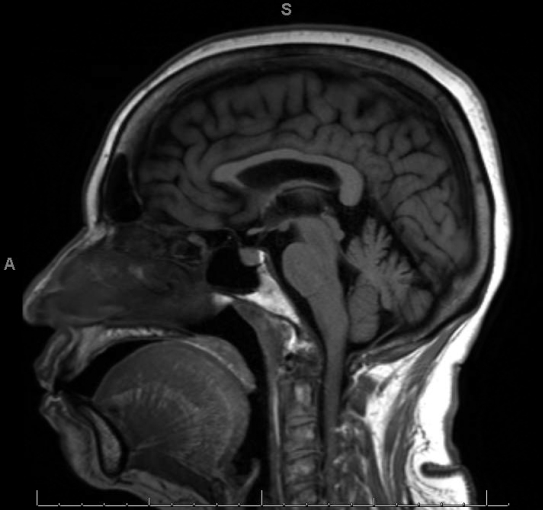Session Information
Date: Wednesday, June 22, 2016
Session Title: Ataxia
Session Time: 12:00pm-1:30pm
Location: Exhibit Hall located in Hall B, Level 2
Objective: To describe a case of hemiatiaxia, parkinsonism, and dystonia associated with anti-Glutamic Acid Decarboxylase (GAD) antibodies.
Background: GAD antibodies have been implicated in endocrinopathies and a variety of neurological manifestations including stiff person syndrome, cerebellar ataxia, epilepsy, and limbic encephalitis with and without a paraneoplastic syndrome. We aim to describe a case of an asymmetric movement disorder in a patient with anti-GAD antibodies.
Methods: A 65-year-old Indian woman, recently diagnosed with insulin-dependent Diabetes Mellitus, presented with a 1-year history of progressive gait impairment requiring use of a walker and right-hand tremor, clumsiness, and posturing. Neurological examination was remarkable for saccadic smooth pursuit and impaired vertical gaze; dysarthria; and right-sided rigidity, bradykinesia, rest tremor, dysmetria, dysdiadochokinesia, and dystonia. Stance was wide based, balance was impaired, and gait was slow, ataxic and showed right foot dystonia. Cortical signs such as apraxia and agraphesthesia were absent.
Results: Diagnostic investigation for treatable causes of ataxia revealed high titers of anti-GAD antibodies in serum (566 nmol/L, normal ≤ 0.02 nmol/L) and CSF (30.3 nmol/L, normal ≤ 0.02 nmol/L). Brain MRI  showed cerebellar vermian atrophy. CT scans of the chest, abdomen, and pelvis showed no evidence of malignancy. She was admitted to hospital for plasma exchange followed by IV Rituximab with mild improvement in symptoms. IV Rituximab every 6 months and physical therapy were continued.
showed cerebellar vermian atrophy. CT scans of the chest, abdomen, and pelvis showed no evidence of malignancy. She was admitted to hospital for plasma exchange followed by IV Rituximab with mild improvement in symptoms. IV Rituximab every 6 months and physical therapy were continued.
Conclusions: Anti-GAD syndromes can present heterogeneously. A combination of asymmetric dystonia, parkinsonism, and ataxia associated with anti-GAD antibodies has not been previously reported based on our review of the literature. This case illustrates the importance of considering anti-GAD antibody syndrome, a potentially treatable condition, in patients with an otherwise unexplained complex movement disorder to facilitate prompt diagnosis and treatment.
To cite this abstract in AMA style:
A.P. Mentreddi, S. Chitnis, P. Khemani. A unique phenotype associated with anti-GAD antibodies [abstract]. Mov Disord. 2016; 31 (suppl 2). https://www.mdsabstracts.org/abstract/a-unique-phenotype-associated-with-anti-gad-antibodies/. Accessed April 18, 2025.« Back to 2016 International Congress
MDS Abstracts - https://www.mdsabstracts.org/abstract/a-unique-phenotype-associated-with-anti-gad-antibodies/
